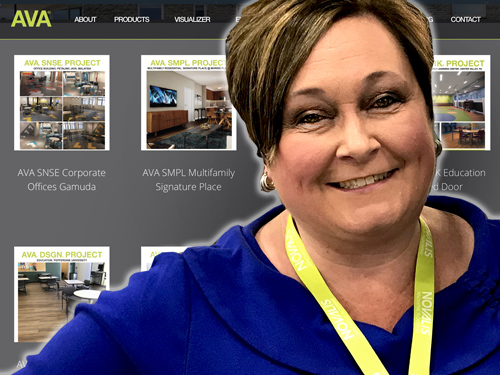
LVT and Mixed-Use Developments
Guest AVA Advisor

Melissa Quick
Commercial Product & Marketing Manager North America, AVA® by Novalis® Innovative Flooring
Melissa Quick has over 30 years of experience in the commercial flooring industry and she attained her LEED GA to gain general knowledge of green building practices and how to support others working on LEED projects.
Reference Images
AVA® SMPL™ High Performance Core construction with attached cork underlayment helps to mitigate sound transfer from floor to ceiling.
Recently, our friends at Floor Trends magazine asked us about the whole topic of mixed-use developments. I immediately asked our AVA® representatives for their thoughts and added theirs to mine. The popularity of mixed-use developments really has taken off, so naturally it’s the subject of a lot of discussion in the design community. Here’s our look at it.
First, what are mixed-use developments? They are a combination of commercial and residential buildings that are built within a city or municipality. These spaces can range from a single building to an entire community. A mixed-use space will typically appeal to both the residents and business owners associated with the development. Residents have access to restaurants, shopping and/or other amenities within the community that in most cases are only short walks from their front door. Business owners gain instant access to potential customers who reside within the development and the local area. It’s actually a brilliant urban planning move that reduces traffic congestion and improves the quality of life.
We’ve seen their appeal on each end of the age spectrum: Millennials and Boomers. They appeal to the Millennial homebuyer or renter because the combination of location, amenities and instant access to a community is highly sought after. Many Millennials may not have the income to purchase a home but want access to all facets the mixed-use development has to offer. Mixed-use developments can also appeal to Baby Boomers as they look to downsize and minimize the maintenance required when owning a home. Many of these spaces are located in densely populated areas, which are highly sought after as it minimizes the commute or provides easier access to public transit for commuters to and from work.

The Avalon in Alpharetta, Georgia
Selecting the proper flooring for the variety of spaces within a mixed-use development is vital, as each space within the community will require certain performance characteristics. The residential units will require a home type feel but be able to withstand the turnover of tenants and contribute towards controlling the sound transfer between units. In the commercial spaces products must be able to hold up to heavy commercial foot traffic, rolling loads and any other special requirements of the space.
Luxury Vinyl Tile & Plank (LVT) has become one of the fastest growing products utilized within mixed-use developments. The combination of durability and design appeals to both the residential units of the community and the commercial spaces. LVT, such as AVA® is offered in a wide variety of visuals so it can fit into almost any design and the various formats make it usable in almost any application. The maintenance and installation of LVT products is very straightforward as most qualified flooring installers can install it without any special requirements.

Crabapple Market in Milton, Georgia
Wood visuals have taken over the residential units as it offers the development owners a realistic wood pattern at a fraction of the cost of real wood. Commercial spaces utilize wood patterns in many instances, however organic visuals offer businesses an opportunity to be creative and create unique spaces. AVA® DSGN® and STYL® are good examples. A wide range of color palettes have been introduced as commercial spaces continue to look for unique designs to set themselves apart from their competitors.
Expect to see more floating and loose lay products with attached acoustical backings in residences. One of the biggest issues within the residential parts of a mixed-use development is the sound transfer between residential units. The attached backings as you’ll find on AVA® SMPL™ being offered on the new rigid core flooring formats can help to mitigate the sound transfer from floor to ceiling. Also, when these formats are used it is easier for the maintenance departments to change out damaged tiles or planks without having to replace the entire unit.
Commercial spaces are starting to utilize the loose lay format of LVT as it offers several advantages for a commercial area. A loose lay product like AVA® DSGN® matches up to carpet tile, which is used quite often in spaces, to minimize any transition between two different flooring products. The installation and repair of damaged tiles or planks is easier than those products that are required to be glued down. During construction access to the spaces can be immediate, whereas with glue down products you typically have to wait 24-48 hours to gain access to the space. Lastly, as tenants move in and out the removal of the floor is simple due to the loose lay format. See Graham Capobianco’s excellent article on “What you need to know about Loose Lay LVT” for more information.
Questions or comments? Let us know by going to the contact page!


